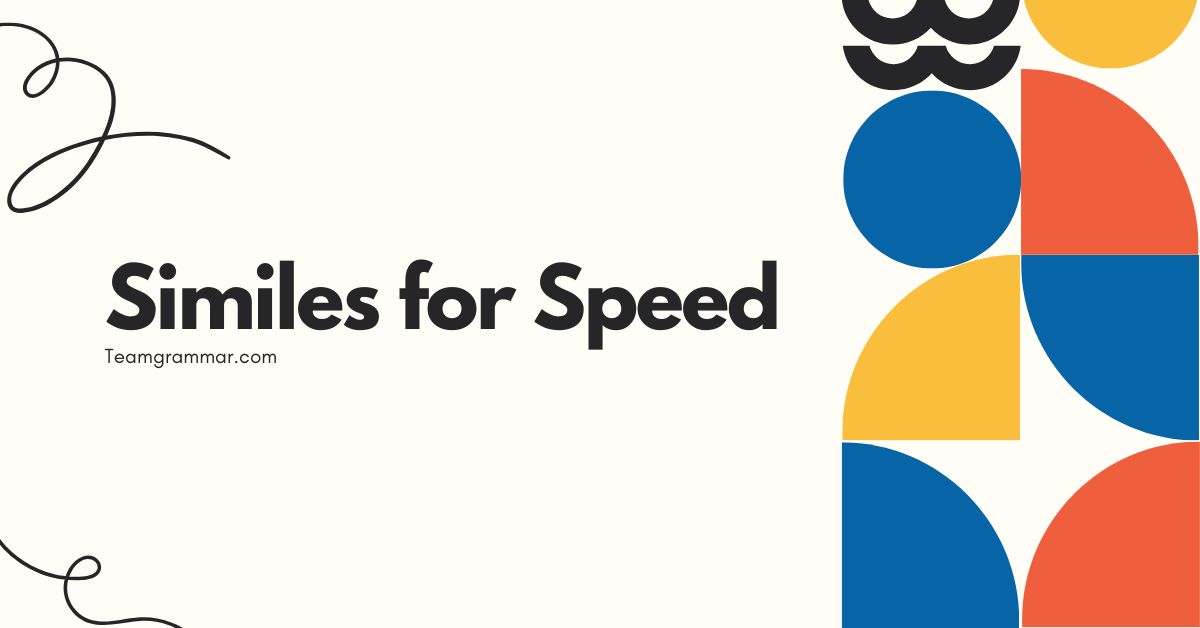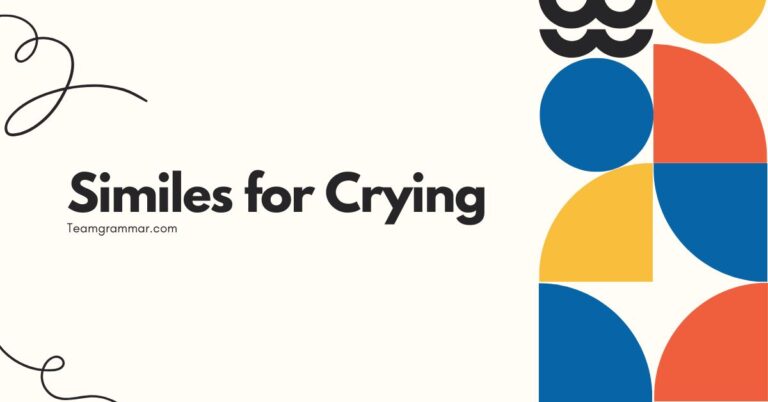29 Similes for Speed: Mastering Figurative Language
Understanding similes is crucial for enhancing both your writing and comprehension skills. Similes, a type of figurative language, allow you to create vivid comparisons, making your descriptions more engaging and impactful.
Specifically, mastering similes related to speed can significantly improve your ability to convey motion, urgency, and swiftness in your communication. This article is designed for English language learners, writers, and anyone looking to enrich their vocabulary and descriptive abilities.
By exploring various similes for speed, their structures, and proper usage, you will be well-equipped to add depth and color to your language.
Table of Contents
- Introduction
- Definition of Similes for Speed
- Structural Breakdown of Speed Similes
- Types and Categories of Speed Similes
- Examples of Similes for Speed
- Usage Rules for Similes of Speed
- Common Mistakes When Using Speed Similes
- Practice Exercises
- Advanced Topics: Nuances and Subtleties
- Frequently Asked Questions
- Conclusion
Definition of Similes for Speed
A simile is a figure of speech that directly compares two unlike things using the words “like” or “as.” It aims to illustrate a shared quality between these things, making the description more vivid and relatable. Similes for speed, specifically, are comparisons that emphasize how fast something or someone is moving.
These similes help to paint a picture of velocity, acceleration, or swiftness in the reader’s mind. They are a powerful tool in descriptive writing, adding color and depth to narratives and making them more engaging.
The main function of similes for speed is to create a more impactful and memorable image of rapid movement. Instead of simply stating that something is fast, a simile can draw a comparison to something known for its speed, enhancing the reader’s understanding and imagination.
They are commonly found in literature, poetry, and everyday conversation, serving to make language more expressive and dynamic. Similes for speed can be used in various contexts, from describing the movement of vehicles to illustrating the pace of a person’s actions or even the speed of thoughts.
Structural Breakdown of Speed Similes
The basic structure of a simile is quite simple:A + like/as + B, where A is the subject being described, and B is the object to which it is being compared. In the context of similes for speed, ‘A’ represents the entity whose speed is being emphasized, and ‘B’ is something inherently fast or associated with speed.
The words “like” or “as” serve as the bridge connecting the two, indicating that the subject shares a quality (speed) with the object of comparison.
For example, in the simile “He ran like the wind,” “He” is the subject (A), “the wind” is the object of comparison (B), and “like” is the connecting word. This structure clearly indicates that his running speed is comparable to the speed of the wind.
Understanding this fundamental structure allows you to construct your own effective similes for speed, enhancing your descriptive writing. The power of a simile lies in the aptness of the comparison; the more relatable and vivid the object of comparison, the more effective the simile becomes.
Types and Categories of Speed Similes
Similes for speed can be categorized based on the specific objects or concepts they use for comparison. Here are a few common categories:
Similes Comparing to Animals
Animals known for their speed, such as cheetahs, rabbits, or birds, are frequently used in similes. These comparisons evoke a natural sense of swiftness and agility.
Similes in this category often highlight the animal’s inherent speed and grace.
Similes Comparing to Natural Phenomena
Natural elements like the wind, lightning, or a shooting star are often used to describe speed. These comparisons convey a sense of uncontrollable, powerful speed, emphasizing the force and velocity of the subject.
Similes Comparing to Vehicles
Vehicles known for their speed, such as race cars, jets, or rockets, provide a modern and technological angle to speed similes. These comparisons emphasize the engineered speed and power of the subject.
Similes Comparing to Abstract Concepts
Abstract concepts like thought or time can also be used in similes for speed. These comparisons often describe the quickness of mental processes or the rapid passage of time, adding a more metaphorical and conceptual layer to the description.
Examples of Similes for Speed
Below are several examples of similes for speed, categorized for clarity. Each category includes a variety of similes to illustrate different aspects of speed and motion.
These examples are designed to provide inspiration and demonstrate the versatility of similes in descriptive writing.
Examples Comparing to Animals
Animals renowned for their speed are a common source of inspiration for similes. These comparisons often evoke a sense of natural agility and swiftness.
The following table presents various examples of similes that utilize animal speed to describe the speed of other subjects.
| Simile | Explanation |
|---|---|
| He ran like a cheetah. | He ran very fast, similar to the speed of a cheetah. |
| She darted away as quick as a rabbit. | She moved away swiftly and suddenly, like a rabbit escaping danger. |
| The car sped off like a bat out of hell. | The car accelerated rapidly, with a sense of wildness and urgency. |
| He swam like a dolphin through the water. | He swam quickly and gracefully, mimicking the fluid motion of a dolphin. |
| The message spread like wildfire. | The message disseminated rapidly and uncontrollably, similar to the spread of a wildfire. |
| The rumour spread as fast as a flock of startled birds taking flight. | The rumour disseminate very fast. |
| The athlete sprinted like a greyhound chasing a lure. | The athlete ran with single-minded determination. |
| The information traveled as swiftly as a swallow in flight. | The information traveled very fast. |
| The football player dodged the defenders like a fox evading hounds. | The football player dodged the defenders very fast. |
| The child scampered across the yard like a squirrel gathering nuts. | The child ran very fast. |
| The dancer moved across the stage as quick as a hummingbird’s wings. | The dancer moved very fast. |
| The cat pounced on the toy like a lion ambushing its prey. | The cat jumped very fast. |
| The news spread through the town like ants marching to sugar. | The news spread very fast. |
| The politician responded to the accusation as quick as a snake striking. | The politician responded very fast. |
| The economy recovered as quickly as a phoenix rising from ashes. | The economy recovered very fast. |
| The ball flew off the bat like a bullet shot from a gun. | The ball flew very fast. |
| The student absorbed the information like a sponge soaking up water. | The student absorbed the information very fast. |
| The argument escalated as rapidly as a swarm of bees defending their hive. | The argument escalated very fast. |
| The project progressed as smoothly as a swan gliding across the water. | The project progressed very fast. |
| The athlete trained like a tireless racehorse. | The athlete trained very fast. |
| The chef chopped vegetables as fast as a beaver gnawing through wood. | The chef chopped vegetables very fast. |
| The company grew as quickly as bamboo shoots in spring. | The company grew very fast. |
| The protesters mobilized as swiftly as a flock of starlings taking flight. | The protesters mobilized very fast. |
| The rescue team responded to the emergency like a hawk swooping down on its prey. | The rescue team responded to the emergency very fast. |
| The athlete ran like a gazelle fleeing from a predator. | The athlete ran very fast. |
Examples Comparing to Natural Phenomena
Natural phenomena such as wind, lightning, and shooting stars offer powerful imagery for describing speed. These similes often convey a sense of unstoppable force and rapid movement.
The table below provides examples of similes that draw comparisons to these natural elements to illustrate speed.
| Simile | Explanation |
|---|---|
| He moved as fast as lightning. | His movements were incredibly quick and sudden, like a lightning strike. |
| She ran like the wind. | She ran with great speed and fluidity, similar to the movement of the wind. |
| The meteor streaked across the sky like a shooting star. | The meteor moved very quickly through the sky. |
| The news spread like a flood. | The news disseminated rapidly and uncontrollably, similar to the overwhelming force of a flood. |
| The rain fell as fast as a waterfall. | The rain fell very fast. |
| The tsunami crashed onto the shore like an avalanche. | The tsunami crashed onto the shore very fast. |
| The river flowed like a torrent after the storm. | The river flowed very fast. |
| The temperature dropped as quickly as the sun setting. | The temperature dropped very fast. |
| The lava flowed like a river of fire. | The lava flowed very fast. |
| The glacier moved as slowly as time itself. | The glacier moved very slow. |
| The tide rushed in like a hungry beast. | The tide rushed in very fast. |
| The fog rolled in as silently as a ghost. | The fog rolled in very fast. |
| The avalanche rushed down the mountain like a roaring giant. | The avalanche rushed down the mountain very fast. |
| The hurricane approached the coast like an angry god. | The hurricane approached the coast very fast. |
| The earthquake struck as suddenly as a thunderclap. | The earthquake struck very fast. |
| The dust devil whirled across the desert like a mischievous spirit. | The dust devil whirled across the desert very fast. |
| The geyser erupted like a sudden explosion. | The geyser erupted very fast. |
| The aurora borealis danced across the sky like ethereal ribbons. | The aurora borealis danced across the sky very fast. |
| The glacier retreated as slowly as a snail crawling. | The glacier retreated very slow. |
| The sandstorm enveloped the city like a suffocating blanket. | The sandstorm enveloped the city very fast. |
| The volcano erupted like a furious dragon. | The volcano erupted very fast. |
| The waterfall cascaded down the cliff like a never-ending stream. | The waterfall cascaded down the cliff very fast. |
| The blizzard swept through the town like an icy broom. | The blizzard swept through the town very fast. |
| The drought withered the land as slowly as a dying ember. | The drought withered the land very slow. |
| The monsoon arrived like a cleansing deluge. | The monsoon arrived very fast. |
Examples Comparing to Vehicles
Vehicles, especially those designed for speed, provide modern and relatable comparisons. Similes using vehicles often emphasize engineered speed and power.
The following table offers examples of similes for speed that utilize various types of vehicles as points of comparison.
| Simile | Explanation |
|---|---|
| The car sped off like a rocket. | The car accelerated very quickly, similar to the rapid launch of a rocket. |
| He drove like a race car driver. | He drove with great speed and skill, similar to a professional race car driver. |
| The train flew by like a bullet. | The train passed very quickly. |
| The motorcycle weaved through traffic like a dart. | The motorcycle moved swiftly and precisely, like a dart thrown accurately. |
| The boat sailed like the wind | The boat sailed very fast. |
| The drone zipped through the air like a hummingbird. | The drone zipped through the air very fast. |
| The airplane soared through the sky like an eagle. | The airplane soared through the sky very fast. |
| The scooter zoomed down the street like a bumblebee. | The scooter zoomed down the street very fast. |
| The helicopter hovered like a dragonfly. | The helicopter hovered very fast. |
| The skateboard rolled down the hill like a runaway train. | The skateboard rolled down the hill very fast. |
| The bicycle flew down the path like a bird in flight. | The bicycle flew down the path very fast. |
| The bus lumbered down the road like a tired elephant. | The bus lumbered down the road very slow. |
| The submarine glided through the water like a silent shark. | The submarine glided through the water very fast. |
| The hot air balloon drifted across the sky like a gentle cloud. | The hot air balloon drifted across the sky very slow. |
| The cruise ship sailed into the sunset like a floating city. | The cruise ship sailed into the sunset very slow. |
| The rickshaw rattled down the street like a noisy cricket. | The rickshaw rattled down the street very fast. |
| The snowmobile sped across the snow like a polar bear chasing its prey. | The snowmobile sped across the snow very fast. |
| The cargo ship plowed through the waves like a determined whale. | The cargo ship plowed through the waves very fast. |
| The tugboat nudged the massive tanker like a small dog guiding a giant. | The tugboat nudged the massive tanker very slow. |
| The firetruck raced to the scene like a superhero answering a call. | The firetruck raced to the scene very fast. |
| The ambulance sped through the streets like a lifeline. | The ambulance sped through the streets very fast. |
| The garbage truck rumbled down the alley like a grumpy bear. | The garbage truck rumbled down the alley very slow. |
| The street sweeper cleaned the road like a meticulous artist. | The street sweeper cleaned the road very slow. |
| The ice cream truck jingled down the block like a siren song. | The ice cream truck jingled down the block very slow. |
| The mail truck ambled along its route like a patient tortoise. | The mail truck ambled along its route very slow. |
Usage Rules for Similes of Speed
When using similes for speed, it’s important to ensure that the comparison is both logical and effective. Here are some key rules to follow:
- Ensure Relevance: The object of comparison should be something generally recognized for its speed. Comparing something to a snail when trying to convey speed would be ineffective.
- Maintain Clarity: The simile should be easily understandable. Avoid obscure or overly complex comparisons that might confuse the reader.
- Avoid Clichés: While some similes are common, overuse can make your writing sound unoriginal. Try to come up with fresh and creative comparisons.
- Consider Context: The context of your writing should influence your choice of simile. A formal document might require a different type of simile than a casual blog post.
Following these rules will help you create similes that are both effective and appropriate for your writing.
Common Mistakes When Using Speed Similes
Even experienced writers can make mistakes when using similes. Here are some common errors to avoid:
- Inaccurate Comparisons: Comparing something slow to something generally considered fast. Incorrect: “He moved like a glacier.” Correct: “He moved like lightning.”
- Overuse of Clichés: Relying too heavily on common similes like “as fast as lightning” without considering more creative options. Incorrect: “He ran as fast as lightning.” Correct: “He ran like a startled deer.”
- Confusing the Reader: Using comparisons that are not easily understood or relatable. Incorrect: “He accelerated like a Higgs boson.” Correct: “He accelerated like a race car.”
By being aware of these common mistakes, you can ensure that your similes are clear, effective, and original.
Practice Exercises
Test your understanding of similes for speed with the following exercises. Each exercise is designed to help you apply what you’ve learned about constructing and using similes effectively.
Exercise 1: Fill in the Blanks
Complete the following sentences with appropriate similes for speed.
| Question | Answer |
|---|---|
| 1. The car sped down the highway _______. | 1. The car sped down the highway like a rocket. |
| 2. She ran across the field _______. | 2. She ran across the field like a cheetah. |
| 3. The news spread through the office _______. | 3. The news spread through the office like wildfire. |
| 4. The jet soared through the sky _______. | 4. The jet soared through the sky like a bullet. |
| 5. He dodged the defender _______. | 5. He dodged the defender like a rabbit. |
| 6. The information travelled _______. | 6. The information travelled as fast as lightning. |
| 7. The economy recovered _______. | 7. The economy recovered as quickly as a phoenix rising from ashes. |
| 8. The ball flew off the bat _______. | 8. The ball flew off the bat like a bullet shot from a gun. |
| 9. The argument escalated _______. | 9. The argument escalated as rapidly as a swarm of bees defending their hive. |
| 10. The project progressed _______. | 10. The project progressed as smoothly as a swan gliding across the water. |
Exercise 2: Identify the Simile
Identify the simile in each sentence and explain what it compares.
| Question | Answer |
|---|---|
| 1. The runner dashed past me like a gust of wind. | 1. Simile: “like a gust of wind.” Compares the runner’s speed to the speed of the wind. |
| 2. The car accelerated as fast as a spaceship launching. | 2. Simile: “as fast as a spaceship launching.” Compares the car’s acceleration to the speed of a spaceship launch. |
| 3. The rumour spread through the town like a flood. | 3. Simile: “like a flood.” Compares the rate at which the rumour spread to the speed and pervasiveness of a flood. |
| 4. The cat pounced on the mouse as quick as lightning. | 4. Simile: “as quick as lightning.” Compares the cat’s pounce to the speed of lightning. |
| 5. The child ran around the yard like a whirlwind. | 5. Simile: “like a whirlwind.” Compares the child’s energy and speed to that of a whirlwind. |
| 6. The economy was growing as fast as bamboo. | 6. Simile: “as fast as bamboo.” Compares the economy to the fast-growing nature of bamboo. |
| 7. The athlete sprinted like a greyhound chasing a lure. | 7. Simile: “like a greyhound chasing a lure.” Compares the athlete to the determination of a greyhound. |
| 8. The information traveled as swiftly as a swallow in flight. | 8. Simile: “as swiftly as a swallow in flight.” Compares the speed of information to the swiftness of a swallow. |
| 9. The dancer moved across the stage as quick as a hummingbird’s wings. | 9. Simile: “as quick as a hummingbird’s wings.” Compares the dancers quickness to the hummingbird’s wings. |
| 10. The company grew as quickly as bamboo shoots in spring. | 10. Simile: “as quickly as bamboo shoots in spring.” Compares the company’s growth to the speed of bamboo shoots. |
Exercise 3: Write Your Own Similes
Create your own similes for speed based on the following prompts.
| Prompt | Your Simile |
|---|---|
| 1. Describe the speed of a race car. | 1. The race car sped around the track like a jet taking off. |
| 2. Describe the speed of a falling star. | 2. The falling star streaked across the night sky like a silver bullet. |
| 3. Describe the speed of gossip spreading. | 3. The gossip spread through the school like a virus. |
| 4. Describe the speed of a cheetah running. | 4. The cheetah ran across the savanna like a blur of yellow and black. |
| 5. Describe the speed of a rocket launching. | 5. The rocket launched into space like a fiery arrow. |
| 6. Describe the speed of a computer processing information. | 6. The computer processed the information as fast as a supercomputer. |
| 7. Describe the speed of a flowing river. | 7. The river flowed as rapidly as a wild horse running through a plain. |
| 8. Describe the speed of a rolling avalanche. | 8. The avalanche moved like a roaring giant down the hill. |
| 9. Describe the speed of a sprinter. | 9. The sprinter ran as fast as a bullet leaving the barrel of a gun. |
| 10. Describe the speed of a car on the highway. | 10. The car sped down the highway like a bat out of hell. |
Advanced Topics: Nuances and Subtleties
For advanced learners, understanding the nuances and subtleties of similes can elevate your writing to a higher level. Consider the emotional impact of your simile.
Does it create a sense of excitement, fear, or awe? Also, think about the cultural context.
Some comparisons may resonate more with certain audiences than others. For instance, comparing speed to a local animal might be more effective in a specific region.
Experiment with combining similes with other figures of speech, such as metaphors or personification, to create richer and more complex descriptions. Pay attention to the rhythm and sound of your similes.
A well-crafted simile should not only be accurate but also pleasing to the ear. The use of alliteration or assonance can enhance the impact of your similes.
Frequently Asked Questions
- What is the difference between a simile and a metaphor?
A simile compares two things using “like” or “as,” while a metaphor directly equates two things without using these words. For example, “He is like a lion” (simile) versus “He is a lion” (metaphor).
- Why are similes useful in writing?
Similes make writing more vivid and engaging by creating comparisons that help readers visualize and understand concepts more clearly. They add color and depth to descriptions.
- How can I avoid using clichés in my similes?
To avoid clichés, try to think of unique and unexpected comparisons. Consider the specific qualities you want to emphasize and brainstorm objects or concepts that share those qualities in a less obvious way.
- Can a simile be too complex?
Yes, a simile can be too complex if it uses obscure references or complicated language that the reader may not understand. Aim for clarity and relatability in your comparisons.
- Is it okay to use more than one simile in a paragraph?
Yes, it is acceptable to use multiple similes in a paragraph, but use them judiciously. Overusing similes can make your writing feel cluttered and distracting. Ensure that each simile adds value and enhances the overall description.
- How do I choose the right object for comparison in a simile?
Choose an object that shares a key characteristic with the subject you are describing and that is easily recognizable and relatable to your audience. The comparison should make sense and enhance understanding.
- Are similes only used in creative writing?
No, similes can be used in various types of writing, including descriptive, persuasive, and even technical writing. They are versatile tools for making complex ideas more accessible and engaging.
- What are some other figures of speech that are similar to similes?
Other figures of speech similar to similes include metaphors, analogies, and personification. Each of these devices uses comparison to enhance understanding and create vivid imagery.
Conclusion
Mastering similes for speed is a valuable skill that can significantly enhance your writing and communication abilities. By understanding the structure, types, and usage rules of similes, you can create vivid and engaging descriptions that capture the essence of rapid movement.
Remember to avoid common mistakes, practice regularly, and explore the nuances of simile usage to elevate your writing to a higher level. The ability to craft effective similes will not only enrich your vocabulary but also improve your overall command of the English language.
Continue to experiment with different comparisons and pay attention to how similes are used in literature and everyday conversation. By actively engaging with the language and refining your skills, you will become more confident and proficient in using similes to add depth, color, and impact to your writing.
Keep practicing, and you’ll soon find yourself using similes effortlessly to bring your words to life.







